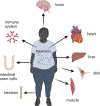Targeting the biology of aging with mTOR inhibitors
- PMID: 37142830
- PMCID: PMC10330278
- DOI: 10.1038/s43587-023-00416-y
Targeting the biology of aging with mTOR inhibitors
Abstract
Inhibition of the protein kinase mechanistic target of rapamycin (mTOR) with the Food and Drug Administration (FDA)-approved therapeutic rapamycin promotes health and longevity in diverse model organisms. More recently, specific inhibition of mTORC1 to treat aging-related conditions has become the goal of basic and translational scientists, clinicians and biotechnology companies. Here, we review the effects of rapamycin on the longevity and survival of both wild-type mice and mouse models of human diseases. We discuss recent clinical trials that have explored whether existing mTOR inhibitors can safely prevent, delay or treat multiple diseases of aging. Finally, we discuss how new molecules may provide routes to the safer and more selective inhibition of mTOR complex 1 (mTORC1) in the decade ahead. We conclude by discussing what work remains to be done and the questions that will need to be addressed to make mTOR inhibitors part of the standard of care for diseases of aging.
© 2023. Springer Nature America, Inc.
Conflict of interest statement
COMPETING INTERESTS
JBM is CEO and co-Founder of Tornado Therapeutics, which is developing safer, more effective mTOR inhibitors to extend human healthspan, and former CMO of resTORbio. DWL has received funding from, and is a scientific advisory board member of, Aeovian Pharmaceuticals, which seeks to develop novel, selective mTOR inhibitors for the treatment of various diseases.
Figures



References
Publication types
MeSH terms
Substances
Grants and funding
LinkOut - more resources
Full Text Sources
Miscellaneous

